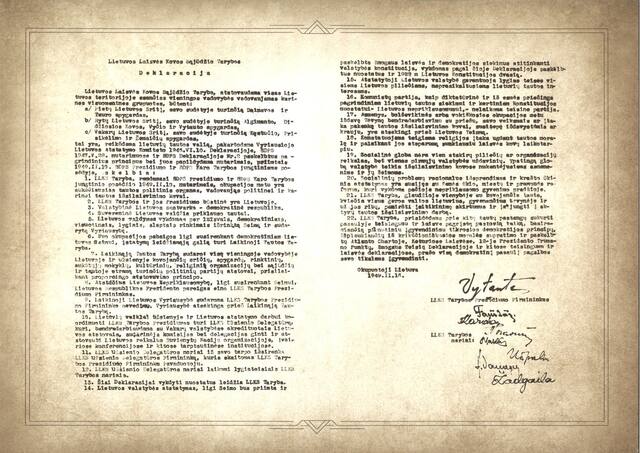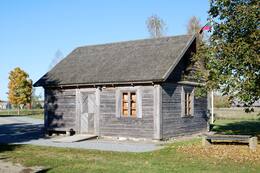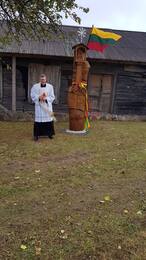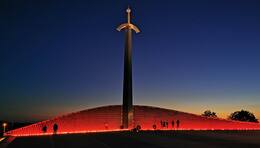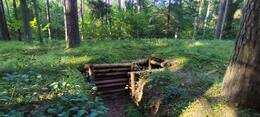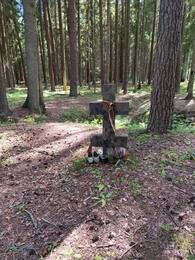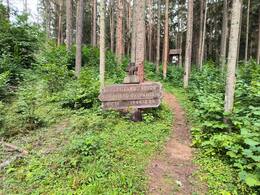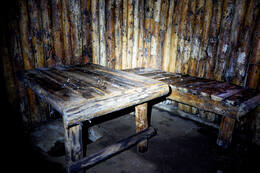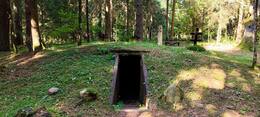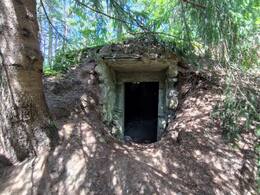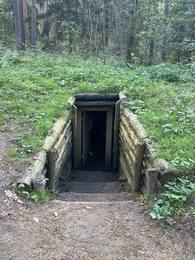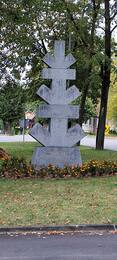Declaration of the Council of the Lithuanian Freedom Struggle Movement
The Declaration of the Lithuanian Freedom Struggle Movement (LLKS Declaration) is the most important document of the Congress of Lithuanian Partisan Commanders, which was adopted on February 16, 1949.
The Declaration set out the program of anti-Soviet resistance, and the Council of the Lithuanian Freedom Struggle Movement was announced. The Declaration discussed the democratic structure of the restored Lithuanian state and other important issues of the time. The independent Republic of Lithuania was to be restored based on the principles set out in the Declaration and the 1922 Constitution.
The declaration was signed by the following partisan leaders: P. Bartkus-Žadgaila, A. Grybinas-Faustas, L. Grigonis-Užpalis, V. Gužas-Kardas, B. Liesys-Naktis, A. Ramanauskas-Vanagas, J. Šibaila-Merainis and J. Žemaitis Vytautas. All of the signatories of the declaration were killed.
In 1999, the Seimas of the Republic of Lithuania adopted a law recognizing the Declaration of the Lithuanian League of Nations as a legal act of the Lithuanian state. The Declaration was included in the Lithuanian National Register of the UNESCO Memory of the World Programme.
More information sources
Related timeline
Related objects
Sąjūdis Memorial to Lithuanian Freedom Fighters in Minaičiai (Minaičiai Bunker-Museum)
In the autumn of 1948, the farm of partisan supporters A. and S. Mikniai in the village of Minaičiai (Radviliškis district) was chosen as the wintering place for the Prisikėlimo Military District headquarters. The partisans dug a small bunker under the barn to house the staff of the district.
On 16 February 1949, the partisan commanders in Minaičiai finalised and published the declaration of the Lithuanian freedom struggle “Sąjūdis”. The main aim of the Declaration was to restore Lithuania to a parliamentary republic (as it was from 1920–1926). Eight people formally attended the meetings: Jonas Žemaitis- Vytautas, Juozas Šibaila-Merainis, Petras Bartkus-Žadgaila, Adolfas Ramanauskas-Vanagas, Aleksandras Gribinas-Faustas, Vytautas Gužas-Kardas, Leonardas Grigonis-Užpalis, and Bronius Liesys-Naktis.
The bunker was also used later. A partisan pharmacist Izabelė Vilimaitė-Stirna treated partisan Laurynas Mingilas-Džiugas, who was seriously wounded in the Battle of Užpelkiai. In 1953, the unoccupied bunker caved in and the owners earth-filled it.
In 2010, the work on the restoration of the partisan bunker and barn, as well as the construction of the monument began. The monument, created by sculptor Jonas Jagėla, bears the names of the partisans who signed the Declaration. An authentic, glassroofed partisan bunker has been built in the barn, and the visitors are provided an opportunity to see it from above; there is also an exhibition in the barn.
Partisan liaison officer's homestead in Saiai
The homestead of the partisan supporters of the Sajės in Balandiškis, Grinkiškis eldership, Radviliškis district, is connected with the struggles for freedom in Lithuania. Its history is usually presented together with the Mikniai homestead, located in nearby Minaičiai (Lithuanian Freedom Movement Memorial).
This secluded and modest homestead, according to the recollections of Viktoras Šniuolis-Vitvytis, an eyewitness to the events, and confirmed by some research, was the place where the founding documents of the Lithuanian Freedom Struggle Movement (LLKS) were probably prepared. The LLKS became the most important organization of resistance to the Soviet occupation, covering the entire territory of Lithuania. It is reported that since 1946, freedom fighters had been visiting this homestead to rest and gain strength. After the partisan liaisons held a congress of partisan commanders at the Mikniai homestead in February 1949, the headquarters of the LLKS Public Division operated at the Sajai homestead (in a bunker installed in a barn), and the LLKS periodical, the newspaper "Prie rymancių rūpintojėlio", was published.
Partisans visited the bunker of the Sajai homestead many times, wintered there, or were treated for injuries. The hearth of freedom at the Sajai homestead existed until 1952. In the autumn of that year, the bunker was discovered, and the owners of the homestead were arrested.
Currently, the homestead is almost completely dilapidated, but it contains a monument, an information stand, and a chapel pillar to commemorate important historical events that took place at this location.
Monument to the partisans of the Resurrection District in Šeduva
On October 14, a monument to the partisans of the Resurrection District was unveiled in Šeduva Laisvės Square. The authors of the monument: sculptor Romanas Kazlauskas, architects Arūnas Eduardas Paslaitis and Viktorija Paslaitytė. It is a joint work of the Lithuanian Genocide and Resistance Research Center (LGGRTC) and the Radviliškis District Municipality.
Monument to the Partisans of the Resurrection District, commemorating all Lithuanian partisans who fought and died in this district in 1944-1953.
This is another monument dedicated to the memory of the Lithuanian partisan districts. The following districts have already been immortalized: Algimantas – Troškūnai, Anykščiai district, Didžioji Kova – Gelvonai, Širvintos district, Tauras – Marijampolė, Žemaičiai – Telšiai and Vytis – Vadokliai, Panevėžys district.
Lithuanian Partisan Memorial in Kryžkalnis
The memorial is located in Kryžkalnis, near the intersection of important roads. The large sword-shaped obelisk marking the memorial is clearly visible when driving along the Klaipėda-Vilnius highway near Kryžkalnis.
The Partisan Memorial is dedicated to honoring the Lithuanian partisans who fought against the Soviet occupation in the post-war period for an independent Lithuania. It is one of the largest places in Lithuania that commemorates the sacrifice and memory of the partisans.
The memorial, created by sculptor Tadas Gutauskas and architect Saulius Pamerneckis, was opened on September 20, 2020. It not only commemorates the victims of the past, but also invites visitors to remember the price of freedom and be proud of their country's history.
The memorial consists of three parts: a 25-meter-high sword-shaped obelisk, which symbolizes the strength and fighting spirit of the partisans, as well as a memorial wall, on which are engraved the names of about 20,000 fallen partisans, arranged in steles in the shape of a Vytis cross, and the Square of Honor with the Tomb of the Unknown Partisan, which symbolizes all those who are unknown and unrecorded, but who sacrificed their lives for Lithuania.
Partisan bunker and memorial cross in Obeliai grove
On July 13, 1945, the Lithuanian partisan Vyties Company fought with Soviet security units in Obeliai grove. In Obeliai grove, the partisans had set up a camp with a bunker in the center. The perimeter of the camp was protected by trenches. After intense two-hour battles, the partisans managed to repel the attack of the Soviet units and successfully withdraw from the camp. In 2003, the partisan bunker was restored in Obeliai grove and a memorial cross was erected.
Along the Trails of the Partisan Battles of the Algimantas Military District
Located in Šimonys Forest, along road No. 1216 (a sign and a stand have been installed). Šimonys Forest was known in the post-war Lithuanian partisan struggle as the centre of activity of the largest partisan unit in Aukštaitija, the Algimantas military district. Approximately 200 partisans were operating in the area in 1945, while by 1952, there were only 20–30. From 1947 to 1949, the Šimonys Forest was used by the commander of the East Lithuania (King Mindaugas) partisan territory, Captain Jonas Kimštas-Žalgiris, and in 1949, by the commander who took over from him, Antanas Starkus–Montė, as hiding places – command posts from which the partisan movement in Aukštaitija was coordinated. The route of the partisan battles of the Algimantas military district invites you to get acquainted with six partisan hideouts of the Algimantas military district, created by the partisans of the Žalioji, Šarūnas and Kunigaikštis Márgiris (King Márgiris) units, who hid and fought here. There are two walking routes of different lengths (5 and 10 km) in Šimonys Forest, which invite you to follow the paths of the partisans.
Antazavė Battle Site and Partisan Dugout Shelter at Lake Vincežeris
The site can be accessed from the town of Antazavė by forest roads.
At the end of 1944, the Lokio Unit of Lithuanian partisans was formed in the area of Antazavė in north-eastern Lithuania. It was led by a former Lithuanian Army officer, Captain Mykolas Kazanas. The unit established five dugout shelters at Lake Vinčežeris, in the uplands of the dense spruce and pine forests of Antazavė.
On 26 December 1944 (27 December according to other sources), the Battle of Antazavė Forest took place here. It was one of the largest partisan battles in eastern Lithuania. The partisan camp was surrounded by Soviet Army units from Utena and Zarasai, as well as soldiers stationed in Antazavė Parish. After a day-long struggle, 85 partisans managed to break the siege and successfully retreated. One partisan died during the retreat.
Currently, two partisan dugouts have been built on the site of the partisan camp, and battle positions, a cross, a memorial plaque, and benches for visitors to the camp have been installed at the site. The partisans’ dugouts are outstanding in terms of their size – they are relatively large and massive underground structures and differed significantly from partisan bunkers that were later built in the forests of Lithuania.
The headquarters bunker of the Žvelgaitis team
The bunker is located in the Gulbinai Forest.
The Kunigaikštis Žvelgaitis detachment was a Northern Lithuanian partisan unit belonging to the Prisikėlimų apygardas, which fought against the Soviet occupation from April 1948 to May 1952. The detachment operated in Joniškis County and part of Šiauliai and Mažeikiai Counties.
The Žvelgaitis squad had a hideout in the Gulbinai forest, which was discovered by soldiers of the MGB internal security unit on March 19, 1952. At that time, 5 partisans from the headquarters of the Prisikėlimų district Kunigaikštis Žvelgaitis squad were in the bunker, 3 of whom - Boleslovas Kriščiūnas-Puntukas (squad commander), Izidorius Miškūnas-Barzda (chief of the squad headquarters) and Stasys Šepkus-Šernas (chief of the Intelligence Department of the squad headquarters) were killed.
The last partisans of Prince Žvelgaitis's squad, Steponas Erstikis-Patašonas, Konstantinas Liuberskis-Žvainys and Julius Adomaitis-Erdvilas, published the newspaper "Partizanų šūviams aidint" (In the Echo of Partizan Shots) in 1952–1956, and "Partizanų šūvių aidas" (Echo of Partizan Shots) in 1956–1957.
In 1998, the bunker was restored, a memorial plaque was installed, and a memorial cross, created by folk artist A. Ganusauskas, was erected near the bunker.
Partisan bunker and memorial cross in Plunksnotiai forest
Partisan Bunker and Memorial Cross can be found by turning off the regional road 3604 (Rokiškis-Maineivos- Naujasodė) between Juodupė and Žiobiškis in the direction of Plunksnočiai Forest.
In 1947, the partisans of the Gediminas Company of the Kunigaikštis Márgiris (King Márgiris) Unit, led by Juozas Bulavas- Iksas, were located in the Plunksnočiai forest stand. Until 1948, they did not have a permanent wintering place, so they took refuge with people who supported them. After World War II, Plunksnočiai Forest was a swampy area with a small mound in the middle of the swamp. In 1949, the partisans set up a hiding place there. However, they were betrayed by an infiltrated Russian security agent, who knew the location of the bunker. On 14 November 1949, after the partisans had fallen asleep, he threw antitank grenades into the bunker. Seven partisans died.
The partisan bunker has been restored and a memorial cross with the names of those who died there has been erected. Today, the surrounding forest is green and walkable. A monument and information signs have been erected in a small square a few dozen metres from the bunker, pursuant to the initiative of the Young Riflemen of Rokiškis.
Eastern Lithuania (King Mindaugas) region Lithuanian partisan command post
After driving past Andrioniškis Cemetery (there is a signpost), there is a preserved hideout – a command post. From 1944– 1949, a command post of the Lithuanian partisans of the Eastern Lithuania (King Mindaugas) region operated in this hiding place. In the summer of 1944, Balys Žukauskas, with brothers Petras and Juozas Jovaišos, established the hiding place to evade the mobilisation announced by the Red Army in 1944. At the end of 1945, Antanas Slučka-Šarūnas started to use the hiding place. He was the first one to form a partisan unit in the Troškūnai area and later united the partisans of Rokiškis, Anykščiai, Kavarskas, Troškūnai, and Andrioniškis to form the Šarūnas Unit. In 1947, A. SlučkaŠarūnas became the commander of the Algimantas district, and in 1949 – the commander of the Eastern Lithuania partisan region. This means that from 1949, the hiding place became the command post of the Lithuanian partisans in the Eastern Lithuania region. The hiding place, which had successfully sheltered partisans for five years, was betrayed on 28 October 1949. The farm where the partisans were hiding was besieged by KGB troops; the partisans refused to surrender and blew themselves up.
The bunker has been preserved, and a cross and a monument to the fallen have been installed.
Monument and Partisan Dugout Shelter of the Narimantas Company of the Kardas Unit
Monument and Partisan Dugout Shelter of the Narimantas company of the Kardas unit are located in the Kretinga district, after turning off road No. 2308 onto Mokyklos Street and approaching the forest near Žibininkai.
In western Lithuania, in Palanga Municipality of the time, a Narimantas (Pušis) company of the Lithuanian Freedom Movement of the Kardas unit of Žemaitija region, commanded by Major Jurgis Ožeraitis, operated from 1947, where men from the area fought. The partisans of Narimantas Company built a bunker in the forests of Alsedžiai, which, as a result of treason, was besieged by the soldiers of the 24th Riflemen Regiment of the Internal Troops of the KGB and the Palanga Parish Destroyer Unit on 7 February 1949. As the partisans tried to break the siege, five members of the company died.
On 18 September 2009, the doors of the restored partisan bunker were ceremoniously opened in Žibininkai Forest on Vilimas Hill. Here, on the initiative of Petras Gabrenas, the former chairman of the Palanga Association of Exiles and Political Prisoners, through the care of Rada Matulevičienė, the owner of the brewery “HBH Juozo”, as well as with the support of the Kretinga Forestry, the former bunker of the Narimantas Company of the Kardas Partisan Unit was authentically restored and a monument was erected.
Monument to Bronislovas Liesis-Nakčiai
In the center of the city of Ramygala, Panevėžys district, on Laisvės Square, in the historical part of the city, stands a monument designed by Jonas Jurgėla (architects Algis Vyšniūnas, Robertas Bardauskas).
A monument dedicated to the memory of Bronislovas Liesis – Nakčia, a signatory of the Declaration of the Council of the Lithuanian Freedom Struggle Movement of February 16, 1949.
B. Liesis and his twin brother Antanas were born in 1922 to the family of the director of the Ramygala Junior High School in Panevėžys County. Their parents were deported to Siberia in 1941, where they died.
During the Nazi occupation, B. Liesis belonged to the Lithuanian Freedom Defenders Union. In 1944, together with his brother, he went to a German military intelligence school on the orders of the Lithuanian Freedom Army, where he studied partisan warfare tactics. On December 21, 1944, he was landed in the forests of Kėdainiai County. Both Liesis reached the Jurbarkas area, and from the beginning of 1945 they fought in the Lydis partisan detachment. From 1948, B. Liesis headed the Prisikėlimos district, edited the newspaper "Prisikėlimos ugnis", and wrote poems under the pseudonym Ēglis. His work was published in the collection "Kovos keliu žengiant" (Walking the Path of Struggle), as well as in the partisan press.
In February 1949, in a bunker set up in the Minaičiai farmstead in Radviliškis district, B. Liesis, together with other representatives of Lithuanian partisan districts, participated in the Congress of Lithuanian partisan commanders, which announced the establishment of a unified resistance organization - the Lithuanian Freedom Struggle Movement. On February 16, the Declaration of the Council of the Lithuanian Freedom Struggle Movement was adopted. At the congress, B. Liesis was appointed a member of the Presidium of the Council of the Lithuanian Freedom Struggle Movement, and he was awarded the rank of freedom fighter partisan captain.
Bronislovas died on August 13, 1949, in a partisan camp set up in the Užpelkiai forest of Grinkiškis parish, Radviliškis county, during battles with MGB soldiers.
Related stories
A fateful meeting in a bunker: the 1949 Congress of Lithuanian Partisan Commanders
On February 10-20, 1949, the only congress of partisan commanders in occupied Lithuania took place in the Mikniai farmstead bunker in the Minaičiai village of Radviliškis district, during which the Lithuanian Freedom Struggle Movement (LLKS) was founded and the Declaration of Independence was proclaimed.
The Last Battle in the Swamp Forest
On August 13, 1949, a fateful battle took place in Radviliškis County, in the Užpelkiai Forest, during which Bronius Liesys-Naktis, a member of the Presidium of the Lithuanian Communist Party Council and a signatory of the February 16 Declaration, was killed, along with other partisans from the Prisikėlimų district.




